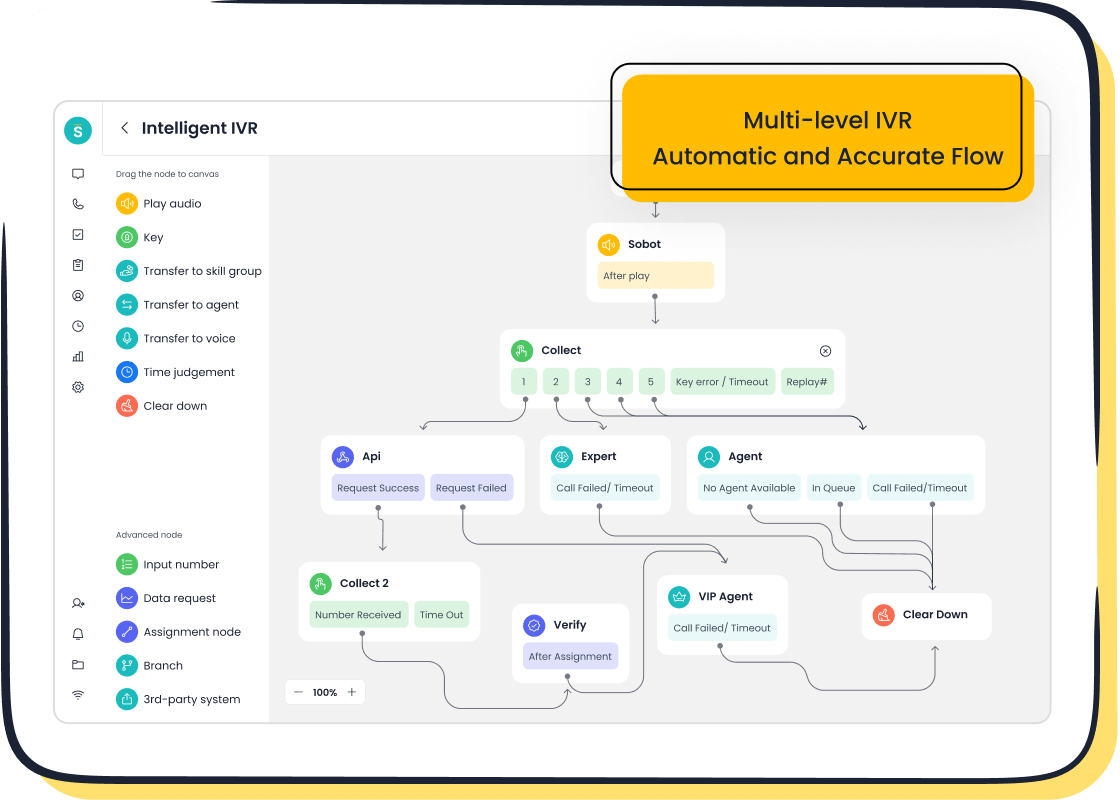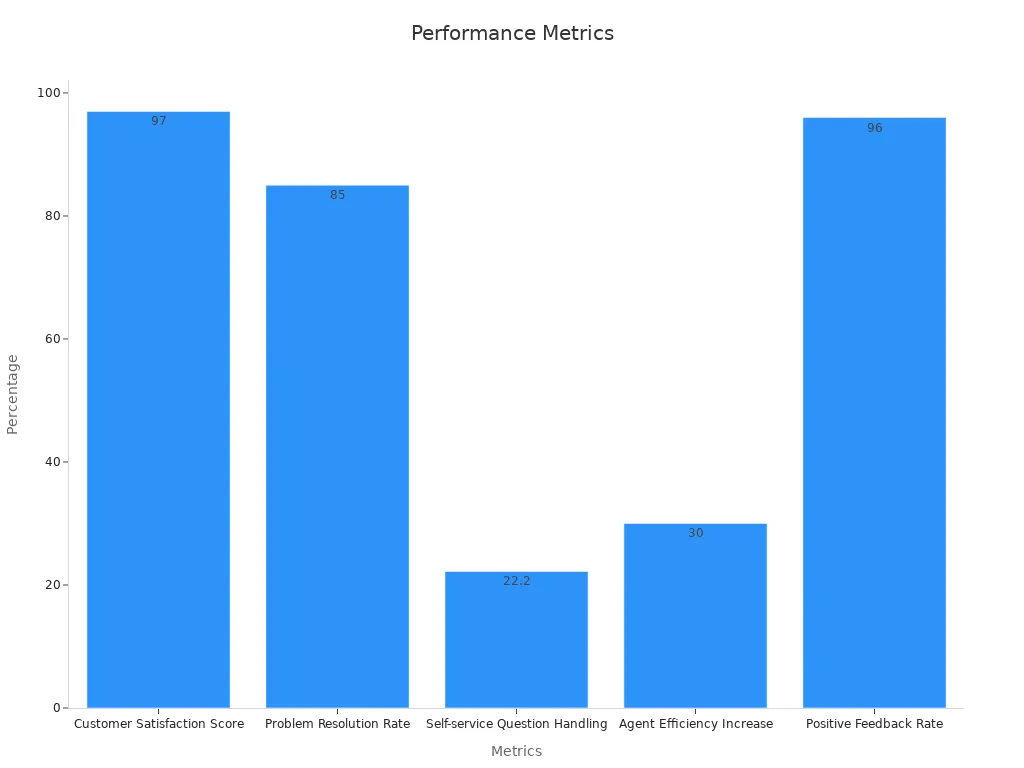Why Omnichannel is Vital for Digital Business Growth

Omnichannel strategies redefine how businesses connect with customers. By integrating digital and physical channels, you create a seamless omnichannel experience that keeps customers engaged and satisfied. Recent studies show that omnichannel customers shop 1.7 times more than single-channel users, boosting both online and in-store spending. Businesses like Zara have seen online sales surge by 74% after adopting these strategies, proving their transformative impact. As over 90% of companies plan to implement omnichannel approaches, tools like Sobot’s solutions make it easier to unify operations and deliver personalized experiences. These strategies don’t just enhance customer satisfaction—they streamline operations and unlock new revenue opportunities.
Understanding Omnichannel and Its Role in Digital Transformation

What is an Omnichannel Experience?
An omnichannel experience ensures that customers interact with your business seamlessly across multiple platforms. Whether they shop online, visit a physical store, or contact customer service, their journey remains consistent and connected. For example, a customer might browse a product on your website, receive a promotional email, and later purchase the item in-store—all while enjoying a unified experience.
Industry leaders define omnichannel experiences as more than just connecting channels. According to IBM, it’s about delivering a unified and consistent experience across all touchpoints, regardless of the platform or device. Sprout Social emphasizes that this approach revolves around delighting customers with seamless interactions. These definitions highlight the importance of integrating digital and physical channels to meet modern customer expectations.
Sobot’s omnichannel solution exemplifies this concept. By unifying communication channels like email, social media, and voice, it empowers businesses to deliver personalized and efficient customer experiences. This approach not only enhances satisfaction but also builds long-term loyalty.
How Omnichannel Drives Digital Transformation
Omnichannel strategies play a pivotal role in accelerating digital transformation. They push businesses to adopt advanced technologies, streamline operations, and meet evolving customer demands. For instance, companies with strong omnichannel execution report 23% higher customer satisfaction and a 15% increase in customer lifetime value. These metrics underscore how omnichannel approaches drive innovation and growth.
Digital transformation thrives on flexibility and integration. Omnichannel strategies enable businesses to offer features like buy-online-pick-up-in-store (BOPIS), which 83% of consumers now expect. This flexibility not only meets customer needs but also enhances operational efficiency. Retailers adopting these strategies often see a surge in e-commerce sales, further fueling their digital growth.

Sobot’s solutions, such as its AI-powered Voice/Call Center, support this transformation. Features like intelligent IVR and unified workspaces streamline customer interactions, making it easier for businesses to adapt to digital demands. By integrating these tools, you can enhance both customer experiences and operational efficiency.
The Connection Between Omnichannel Retailing and Retail Digital Transformation
Omnichannel retailing is reshaping the retail landscape by merging online and offline experiences. This transformation is evident in grocery supply chains, where omnichannel strategies have evolved to meet the rising demand for online shopping. During the COVID-19 pandemic, many retailers faced challenges in integrating their digital and physical channels. However, those who succeeded gained a competitive edge.
A study on retail supply chains highlights how omnichannel approaches are transforming logistics. Companies are adopting technologies like AI to address challenges in fulfillment and meet high consumer expectations. For example, automation in e-commerce has become essential as online sales continue to grow. Retailers who embrace these changes not only improve their cost management but also enhance customer satisfaction.
Sobot’s omnichannel solution addresses these challenges by providing a unified platform for managing customer interactions. Its integration capabilities and AI-driven insights help retailers optimize their operations and deliver seamless experiences. By adopting such solutions, you can stay ahead in the competitive retail market.
Key Benefits of Omnichannel Strategies for Businesses
Enhancing Customer Engagement and Loyalty
Omnichannel strategies elevate customer engagement by creating seamless and personalized experiences across multiple platforms. When customers interact with your brand, whether through social media, email, or in-store visits, they expect consistency. Meeting this expectation builds trust and fosters loyalty. Research shows that brands with strong omnichannel engagement retain up to 89% of their customers. This retention rate highlights the importance of delivering integrated experiences that reduce friction in the customer journey.
Approximately 65% of brands with loyalty programs plan to invest in omnichannel experiences to enhance repeat patronage. Companies that prioritize these strategies see repeat purchases and customer lifetime value increase by over 1.5 times year-on-year. For example, Starbucks has successfully implemented an omnichannel retail strategy by integrating its mobile app with in-store experiences, allowing customers to order ahead and earn rewards seamlessly. This approach not only boosts engagement but also strengthens customer loyalty.
Sobot’s omnichannel solution empowers businesses to achieve similar results. By unifying communication channels and leveraging AI-driven insights, you can deliver personalized interactions that keep customers coming back. Features like automated chatbots and unified workspaces streamline engagement, ensuring every interaction feels tailored and efficient.
Boosting Sales and Revenue with Omnichannel Retailing
Omnichannel retailing drives revenue growth by enhancing the shopping experience and increasing conversion rates. Companies with strong omnichannel customer engagement report a 9.5% year-over-year increase in annual revenue, compared to just 3.4% for those with weaker strategies. Personalized experiences, such as targeted promotions and seamless transitions between online and offline channels, encourage customers to spend more.
SymphonyAI’s research reveals that AI-driven insights can boost grocery e-commerce revenue by 8%. Retailers using connected retail products enhance shopper engagement and drive omnichannel growth. Brands like Nike and Sephora have set high standards for integrated experiences, demonstrating how omnichannel retailing can transform customer trust into tangible sales growth.

Sobot’s Voice/Call Center plays a crucial role in supporting these strategies. Its intelligent IVR system and AI-powered Voicebot enable businesses to handle high call volumes efficiently while providing personalized service. By integrating these tools, you can optimize customer interactions and drive higher conversion rates, ultimately boosting your bottom line.
Improving Operational Efficiency Through Integration
Omnichannel strategies improve operational efficiency by consolidating systems and automating workflows. Unified platforms eliminate silos, reduce duplication of efforts, and streamline business operations. Companies that integrate customer data across channels experience faster fulfillment speeds and greater accuracy, enhancing productivity and reducing costs.
For example, automation features in omnichannel solutions reduce manual efforts, allowing support teams to focus on complex tasks. Fulfillment speed and accuracy improve, ensuring customers receive their orders promptly. These efficiencies translate into better customer satisfaction and lower operational expenses.
Sobot’s omnichannel solution exemplifies this integration. Its unified workspace consolidates customer data, enabling agents to resolve issues quickly and effectively. AI-driven analytics provide actionable insights, helping businesses optimize workflows and improve productivity by up to 30%. By adopting such solutions, you can enhance operational efficiency while delivering exceptional customer experiences.
Challenges in Implementing Omnichannel Strategies
Overcoming Integration and Technology Barriers
Implementing an omnichannel strategy often requires businesses to overcome significant integration and technology challenges. Many companies struggle with data silos, which prevent a complete view of customer journeys. Fragmented marketing stacks further complicate campaign management and analysis, leading to inconsistent customer experiences. These issues can reduce engagement and hinder the delivery of personalized interactions.
Successful examples show how businesses can address these barriers. Target modernized its supply chain and created a unified commerce platform, resulting in a 31% increase in digital sales and a 25% improvement in customer satisfaction. Similarly, Siemens leveraged IoT and AI to streamline operations, boosting production efficiency by 30%. These cases highlight the importance of adopting advanced technologies and integrating systems to create seamless customer experiences.
Sobot’s omnichannel solution simplifies this process by unifying communication channels and providing AI-driven insights. Its integration capabilities ensure businesses can connect existing systems, enabling a consistent and efficient customer journey.
Managing Costs and Resource Allocation
Cost management is another challenge when adopting omnichannel strategies. Businesses often face high upfront investments in technology, infrastructure, and training. Allocating resources effectively becomes critical to ensure a return on investment. Without proper planning, these costs can outweigh the benefits.

To address this, companies should prioritize scalable solutions that grow with their needs. Automation tools, like Sobot’s AI-powered Voice/Call Center, reduce operational costs by streamlining workflows and handling repetitive tasks. For example, Sobot’s intelligent IVR system allows businesses to manage high call volumes efficiently, cutting down on labor expenses. By focusing on tools that enhance productivity, you can optimize resource allocation and achieve long-term savings.
Ensuring Employee Adoption and Training
Even the best omnichannel strategies can fail without employee buy-in and proper training. Employees need the skills to use new tools and adapt to integrated workflows. A lack of training can lead to inefficiencies and lower morale.
Effective training models address these challenges. Start by identifying skill gaps through needs assessments. Provide accessible, role-specific training that employees can apply immediately. Encourage participation by fostering a culture of growth and collaboration. Measuring the success of training programs ensures continuous improvement. For instance, companies that partner with educational institutions often enhance training quality and employee engagement.
Sobot supports businesses in this area by offering user-friendly platforms and ongoing training resources. Its unified workspace simplifies workflows, making it easier for employees to adopt new systems and deliver exceptional service.
How Sobot’s Omnichannel Solutions Empower Businesses

Leveraging Sobot’s Voice/Call Center for Seamless Customer Interactions
Sobot’s Voice/Call Center transforms how businesses manage customer interactions. Its intelligent IVR system ensures calls are routed efficiently, reducing wait times by 35%. This feature allows your team to focus on resolving issues rather than navigating complex workflows. The platform also supports global telephony, enabling you to connect with customers worldwide while maintaining a 99.99% system uptime.

The Voice/Call Center enhances agent productivity through a unified workspace. Agents can access customer data and call histories in one place, improving resolution rates by 85%. Additionally, AI-powered Voicebots handle repetitive queries, freeing up agents for more complex tasks. These capabilities create a seamless shopping experience for your customers, boosting satisfaction rates to 97%.

By integrating Sobot’s Voice/Call Center, you can deliver a personalized customer experience while optimizing operational efficiency. This seamless integration ensures every interaction feels tailored and professional.
Unified Workspaces and AI-Driven Insights for Better Decision-Making
Sobot’s omnichannel solution provides a unified workspace that consolidates customer interactions across platforms like email, social media, and voice. This integration eliminates data silos, enabling your team to deliver personalized customer experiences. For example, agents can view a customer’s purchase history and preferences, ensuring consistent service across all touchpoints.
AI-driven analytics further enhance decision-making. The platform offers actionable insights into customer behavior and agent performance. These insights help you identify trends, optimize workflows, and allocate resources effectively. Businesses using Sobot’s solutions report a 30% increase in agent efficiency and faster problem resolution.
This unified approach not only improves customer satisfaction but also streamlines your operations. By leveraging these tools, you can make data-driven decisions that drive growth and enhance the customer journey.
Real-World Success: How Opay Transformed Customer Service with Sobot
Opay, a leading financial service platform, faced challenges managing interactions across multiple channels. By adopting Sobot’s omnichannel solution, Opay integrated social media, email, and voice into a single system. This seamless integration streamlined operations and improved service delivery.
The results were remarkable. Customer satisfaction soared from 60% to 90%, while operational costs dropped by 20%. The intelligent IVR system allowed 60% of customers to resolve issues independently, reducing the workload on agents. Additionally, WhatsApp Business integration achieved an 85% message reading rate, enhancing marketing outreach.
Opay’s success demonstrates the transformative power of Sobot’s solutions. By unifying communication channels and leveraging AI-driven tools, you can achieve similar results, improving both customer satisfaction and operational efficiency.
Actionable Steps to Adopt Omnichannel Approaches
Mapping the Customer Journey for a Cohesive Experience
Mapping the customer journey is the foundation of a successful omnichannel strategy. It helps you identify key touchpoints, understand customer expectations, and uncover pain points. This process ensures seamless interaction between channels, creating a cohesive experience that customers value. Businesses that effectively map their customer journey report a 20% increase in satisfaction and a 15% boost in revenue.
To start, document every step of your customer’s journey, from initial awareness to post-purchase engagement. Highlight areas where friction occurs, such as long wait times or inconsistent communication. For example, Starbucks uses location-based personalization and mobile ordering to streamline its customer journey, resulting in higher retention rates. By addressing pain points, you can enhance satisfaction and loyalty.
Sobot’s omnichannel solution simplifies this process. Its unified workspace consolidates customer data, allowing you to analyze touchpoints and deliver personalized experiences. With AI-driven data insights, you can continuously refine your strategy to meet evolving customer needs.
Integrating Advanced Tools Like Sobot’s Omnichannel Solution
Advanced tools are essential for implementing a seamless omnichannel strategy. They enable you to connect multiple channels, automate workflows, and provide consistent support. Companies like Maruti Suzuki have demonstrated the power of integration, using AI chatbots to engage over 400,000 users and handle millions of queries efficiently.

Sobot’s omnichannel solution offers similar benefits. It integrates communication channels like voice, email, and social media into a single platform. Features like AI-powered chatbots and intelligent IVR systems automate repetitive tasks, freeing up your team to focus on complex issues. NICE’s case study highlights how AI-driven tools improve customer satisfaction by understanding needs and delivering seamless experiences.
By adopting Sobot’s solution, you can unify operations and enhance efficiency. Its integration capabilities ensure real-time data syncing, enabling your team to provide consistent and personalized service across all channels.
Building a Data-Driven Strategy for Continuous Improvement
A data-driven strategy ensures your omnichannel approach evolves with customer expectations. Use analytics to track metrics like customer satisfaction, average handling time, and first-contact resolution rates. Businesses that prioritize continuous improvement see a 20-30% increase in satisfaction and significant reductions in handling time.
Start by collecting data from all customer interactions. Analyze trends to identify areas for optimization. For example, Sobot’s omnichannel solution provides actionable insights through AI-driven analytics. These insights help you allocate resources effectively and refine workflows. A unified workspace ensures your team has access to real-time data, enabling faster problem resolution.
Continuous improvement requires regular evaluation. Measure KPIs and adjust your strategy based on performance. This approach not only enhances customer experiences but also drives long-term growth.
Omnichannel strategies redefine how businesses operate in the digital age. They enable a customer-centric operation by integrating channels and delivering an enhanced customer experience. Research shows omnichannel customers spend 15-30% more, while 75% of consumers visit stores after finding local information online. Digital touchpoints now influence nearly half of U.S. retail sales.
| Evidence Type | Description |
|---|---|
| Increased Spending | Omnichannel customers spend 15 to 30% more than single or multi-channel customers. |
| Store Visits | 75% of consumers are more likely to visit a store if they find local retail information online. |
| Digital Touchpoints Impact | Digital touchpoints affect approximately 49% of total U.S. retail sales. |
| Sales Increase | Stores with digital signs near checkout lines have seen sales increases of up to 33%. |
Sobot’s solutions, like its Voice/Call Center and Omnichannel Solution, empower businesses to overcome challenges and achieve sustainable growth. By adopting these tools, you can deliver seamless, personalized experiences that drive long-term success.
FAQ
What is retail digital transformation, and why is it important?
Retail digital transformation involves integrating digital technologies into retail operations to improve efficiency and customer experiences. It helps businesses adapt to changing consumer shopping behavior, streamline processes, and boost revenue. For example, implementing click and collect services enhances convenience and drives customer satisfaction.
How does omnichannel strategy impact consumer shopping behavior?
Omnichannel strategies influence consumer shopping behavior by providing seamless experiences across platforms. Customers can browse online, purchase in-store, or use click and collect options. This flexibility increases engagement and loyalty. Studies show that omnichannel customers spend 15-30% more than single-channel shoppers.
What challenges do businesses face during transformation?
Businesses often encounter challenges like integrating systems, managing costs, and training employees. For example, fragmented communication channels can hinder efficiency. Sobot’s omnichannel solution addresses these issues by unifying platforms and automating workflows, ensuring a smoother transformation process.
How can Sobot’s solutions support retail digital transformation?
Sobot’s omnichannel solution integrates communication channels like email, social media, and voice. It provides AI-driven insights and unified workspaces, enabling businesses to optimize operations and deliver personalized customer experiences. These tools help retailers adapt to digital demands and enhance customer satisfaction.
Why is click and collect essential for modern retail?
Click and collect combines online shopping with in-store pickup, offering convenience and speed. It meets the expectations of today’s consumers, who value flexibility. Retailers adopting this service often see increased foot traffic and higher sales, making it a vital part of retail digital transformation.
See Also
Essential Tips for Choosing Omnichannel Call Center Tools
A Comprehensive Approach to Omnichannel Contact Center Setup
The Impact of Live Chat Software on Ecommerce Sales
